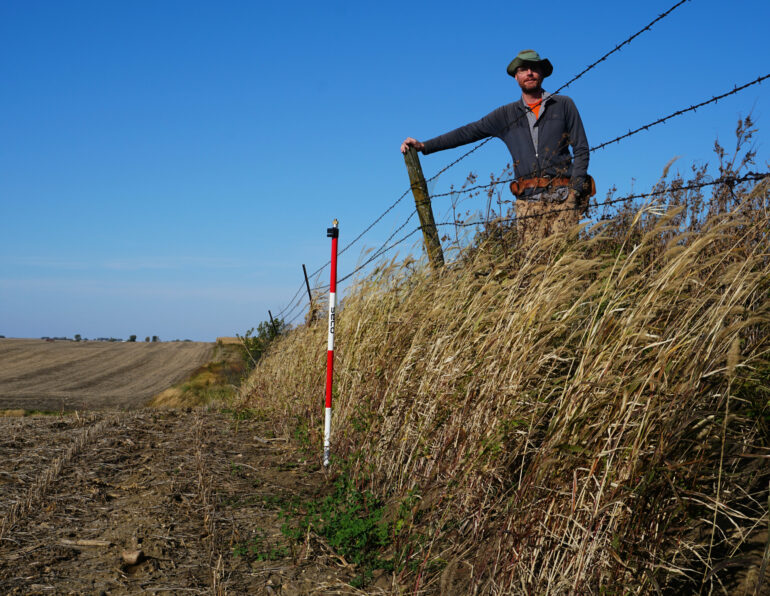A new study in the journal Earth’s Future led by the University of Massachusetts Amherst shows that, since Euro-American settlement approximately 160 years ago, agricultural fields in the midwestern U.S. have lost, on average, two millimeters of soil per year. This is nearly double the rate of erosion that the USDA considers sustainable. Furthermore, USDA estimates of erosion are between three and eight times lower than the figures reported in the study. Finally, the study’s authors conclude that plowing, rather than the work of wind and water, is the major culprit.
“A few years back, my wife and I were at a wedding at a pioneer Norwegian church in Minnesota,” says Isaac Larsen, professor of geosciences at UMass Amherst and one of the paper’s co-authors. “After the ceremony, I walked over to the edge of the churchyard, which was surrounded by cornfields, and was shocked to see that the surface of the field was a few feet lower than the surface of the never-tilled churchyard. I began to wonder why.”
Fast forward a few years, and Larsen, along with the paper’s co-lead authors, Evan Thaler, who completed the research as part of his Ph.D. at UMass Amherst, and Jeffrey Kwang, a postdoctoral researcher at UMass Amherst at the time of the study, found himself standing in central Iowa on the “escarpment,” or drop-off, separating a native prairie from a field of soybeans.
Thaler had worked extensively with the Iowa Natural Heritage Foundation and other organizations to pinpoint the few remaining pockets of original, never-farmed prairie. He then reached out to the farmers whose land abutted the prairies, asking them for permission to survey their fields. Thaler wound up with twenty sites, the majority of them in central Iowa, with a few in Illinois, Minnesota, South Dakota, Kansas and Nebraska. “I spent days driving around the Midwest, knocking on doors,” said Thaler. “People want to see your face and have a conversation before they let you onto their land. No one turned me away when I showed up in person.”
Once Thaler had secured the landowner’s permission, the team went to work. Using an extraordinarily sensitive GPS unit that looks more like a floor lamp than a hand-held device, the team walked dozens of transects, or perpendicular routes across the escarpment, from the untouched prairie to the eroded farm field, stopping every few inches to measure the change in altitude. They did this hundreds of times throughout the summers of 2017, 2018 and 2019.
Once they had their raw data, the team used historical land-use records and cutting-edge computer models to reconstruct erosion rates throughout the Midwest. What they discovered is that Midwestern topsoil is eroding at an average rate of 1.9 millimeters per year. Put another way, the authors estimate that the Midwest has lost approximately 57.6 billion metric tons of topsoil since farmers began tilling the soil, 160 years ago. And this is despite conservation practices put in place in the wake of the Dust Bowl in the 1930s.
It’s also clear that much of the erosion is due to tillage—to plowing. “The modeling that I do shows that tilling has a ‘diffusive’ effect,” says Kwang. “It melts the landscape away, flattening higher points in a field and filling in the hollows.” But because the USDA does not explicitly include such “tillage erosion” in its own analysis, it has “drastically underestimated the rate of erosion” currently at work in the heartland, says Thaler.
“As erosion degrades our soils, it reduces our ability to grow food,” says Larsen. “Combine this with increasing global population and climate stress, and we have a real problem.” The team suggests that more sustainable practice, such as no-till farming and soil regeneration, “will likely be required to reduce soil erosion rates in the Midwest to levels that can sustain soil productivity, ecosystem services, and long-term prosperity.”
More information:
Evan A. Thaler et al, Rates of Historical Anthropogenic Soil Erosion in the Midwestern United States, Earth’s Future (2022). DOI: 10.1029/2021EF002396
Provided by
University of Massachusetts Amherst
Citation:
Midwestern US has lost 57.6 billion metric tons of soil due to agricultural practices, study finds (Update) (2022, March 16)



